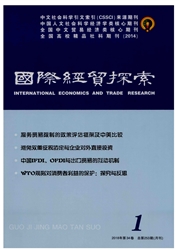

 中文摘要:
中文摘要:
文章使用中国工业企业一海关匹配数据,研究不同出口贸易方式、出口强度对企业研发选择与绩效的影响。研究发现,出口企业选择研发的概率高于不出口企业。出口企业中,一般贸易企业选择研发的概率高于混合贸易企业和加工贸易企业,混合贸易企业选择研发的概率高于加工贸易企业。研究还发现,研发在短期内并不能促进出口企业的生产率,原因是研发存在滞后效应,需要较长时间才能对生产率提升产生影响。进一步研究表明,无论哪种类型出口企业,低出口强度企业拓展国际市场.提高出口强度:高出口强度企业拓展国内市场,降低出口强度都将提高研发概率与绩效。这表明,出口企业在转型过程中需要充分利用国内与国际两个市场,积极拓展市场范围.充分发挥市场拓展与研发的协同效应.实现转型升级。
 英文摘要:
英文摘要:
This paper applies China's industrial firm-custom data to research the effect of different types of export and export density on enterprise R&D selection and performance. It finds that the R&D probability of all export enterprises is higher than that of non-export enterprises. In export enterprises, the R&D probability of the general trade enterprises is higher than that of the mixed trade enterprises and the processing trade enterprises, and the R&D probability of the mixed trade enterprises is higher than that of the processing trade enterprises. It also finds that R&D behavior does not improve the productivity of export enterprises in the short term. The reason is that there is the lagged effect in R&D, which takes a long time to improve the productivity. Further studies show that the low export density enterprises expand the international market and increase export density; the high export density enterprises expand domestic market and reduce export density. Both will increase R&D probability and performance. This finding suggests that export enterprises in the process of restructuring should fully use both domestic and international markets to actively expand their market scope, give full play to the synergy of market expansion and R&D selection, enhance productivity, and achieve transformation and upgrading.
 同期刊论文项目
同期刊论文项目
 同项目期刊论文
同项目期刊论文
 期刊信息
期刊信息
